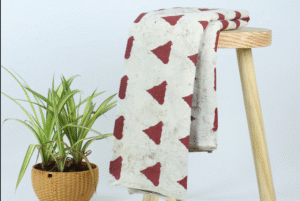
Dabu print fabric represents one of the finest legacies of traditional Indian textile printing. Originating from Rajasthan, this fabric is not merely a material—it’s a canvas of culture, craftsmanship, and sustainable fashion. As a hand-block printing technique that uses mud-resist printing, Dabu printing reflects the depth of Indian artistry and the ingenuity of natural dyeing practices.
What Is Dabu Print Fabric?
Dabu print fabric is a type of mud-resist hand block-printed cotton textile that features intricate motifs created through a multi-step, eco-conscious process. The word “Dabu” is derived from the Hindi word dabana, which means “to press.” The fabric is made using wooden blocks dipped in a mud-resist paste, followed by natural dyeing and washing, often multiple times.
The process not only yields beautiful and timeless designs but also ensures that each piece of Dabu fabric is unique, due to its handmade nature and organic variations.
History and Origin of Dabu Printing
Dabu printing has its roots in the ancient villages of Rajasthan, especially in regions like Bagru, Akola, and Kaladera. The practice dates back to the 8th century, when artisans began using mud, gum, and natural ingredients to create patterns resistant to dyes.
This heritage craft was almost lost in the 20th century due to industrialization and synthetic printing. However, efforts by traditional artisan communities and ethical fashion brands have revived its popularity. Today, Dabu print fabric stands as a symbol of slow fashion, sustainability, and indigenous craftsmanship.
The Unique Process of Dabu Printing
Creating Dabu print fabric is a labor-intensive, multi-stage process that blends earth, water, and time-tested skill:
1. Preparing the Fabric
High-quality cotton fabric is sourced and thoroughly washed to remove starch, dirt, or grease. The clean surface ensures better absorption of dyes.
2. Block Printing with Mud-Resist Paste
The artisan prepares a mud-resist paste using a mixture of:
-
Black clay (mitti)
-
Gum (usually from the babool tree)
-
Lime
-
Wheat chaff
This thick paste is applied using intricately carved wooden blocks, hand-pressed to print the resist onto the fabric. Sawdust is sprinkled over the printed areas to prevent smudging and assist in drying.
3. Drying
The printed fabric is dried naturally under sunlight, a critical step for the resist to harden and adhere properly to the fabric.
4. Dyeing
The fabric is dyed in natural vegetable or indigo dyes, depending on the desired color. The resist-printed areas remain undyed, preserving the base fabric’s color.
5. Washing and Finishing
Post-dyeing, the fabric is thoroughly washed in running water or natural streams to remove the mud resist. What emerges is a beautifully patterned textile with sharp, earthy motifs and traditional appeal.
Types of Motifs and Designs in Dabu Print
Dabu prints are known for their rustic aesthetics and deep cultural symbolism. Common motifs include:
-
Floral patterns: Inspired by Mughal gardens and nature
-
Geometric designs: Diamonds, chevrons, and dots
-
Animal figures: Elephants, birds, and peacocks
-
Folklore and tribal symbols: Representing local myths and traditions
Each motif is hand-carved on wooden blocks and passed down through generations of skilled artisans, often reflecting regional narratives.
Popular Variants of Dabu Print Fabric
There are several variants of Dabu print based on dye combinations and layering techniques:
Indigo Dabu
Dyed in natural indigo vats, this deep blue variant is the most iconic. Its bold contrast with white or beige resist patterns is highly sought after in fashion.
Double Dabu (Double Resist)
A more complex version where the resist-dye process is repeated to achieve multiple shades and layered motifs. It showcases fine detailing and depth of design.
Bagru Dabu
This variant comes from Bagru and incorporates red and black natural dyes derived from alizarin and iron acetate. It features earthy tones and symmetrical patterns.
Applications of Dabu Print Fabric
The earthy charm and versatile elegance of Dabu fabric make it suitable for a wide range of uses:
1. Clothing
-
Kurtas, sarees, salwar suits, and dupattas
-
Shirts, skirts, dresses, and jackets for fusion and western wear
-
Children’s clothing is made due to the use of natural dyes
2. Home Décor
-
Cushion covers, curtains, table linens, and upholstery
-
Adds a boho-chic, artisanal aesthetic to interiors
3. Accessories
-
Handbags, scarves, stoles, and pouches
-
Combines functional use with cultural heritage
Why Choose Dabu Print Fabric?
Eco-Friendly and Sustainable
The use of natural dyes and biodegradable resist paste makes Dabu printing one of the most environmentally friendly textile arts. It promotes ethical fashion and supports zero-waste practices.
Cultural Significance
By choosing Dabu, you’re investing in living history and rural craftsmanship, helping preserve centuries-old artisan traditions.
Breathable and Skin-Friendly
Made predominantly from pure cotton, Dabu fabrics are ideal for all seasons, especially in tropical climates.
Unique and Handcrafted
Every piece of Dabu is handmade, resulting in subtle imperfections that add authenticity and charm. No two pieces are exactly alike.
Caring for Dabu Print Fabric
To maintain the beauty and longevity of your Dabu prints, follow these care tips:
-
Hand wash separately in cold water using mild detergent
-
Avoid direct sunlight when drying to prevent fading
-
Do not bleach
-
Iron on the reverse side to preserve the printed motifs
How to Identify Authentic Dabu Print Fabric
Genuine Dabu prints exhibit certain characteristics:
-
Slight bleeding of dye or minor misalignments in prints (signs of handcrafting)
-
Natural, earthy scent from mud-resist and dye
-
Uneven textures where mud resist was applied
-
Available mostly through artisan cooperatives, craft fairs, or certified handloom outlets
Avoid machine-perfect patterns and overly bright synthetic colors, which are often signs of imitation.
Where to Buy Dabu Print Fabric
To support authentic artisans, consider purchasing from:
-
Fair trade platforms
-
Government-backed handloom emporiums
-
Online stores promoting sustainable fashion
-
Boutiques sourcing directly from Rajasthan
Buying from reputable sources ensures fair wages to artisans and the continuation of traditional techniques.
The Revival of Dabu in Modern Fashion
Dabu print has made a striking comeback in recent years, thanks to its fusion appeal and sustainable ethos. Designers are incorporating Dabu in runway collections, urban streetwear, and eco-conscious brands. This blend of tradition with contemporary design has given Dabu a global platform and renewed recognition.
Fashion-forward consumers now see Dabu prints not just as ethnic wear, but as a statement of slow, mindful fashion that values people, process, and planet.
Conclusion
Dabu print fabric is more than just a textile—it’s a celebration of artisanal skill, ecological responsibility, and cultural preservation. In a world leaning toward sustainability and conscious consumption, Dabu printing offers a rich blend of aesthetic elegance and environmental wisdom. Whether in your wardrobe or your home, incorporating Dabu is a way to honor heritage while embracing contemporary style.
![1ND8012xBlack-Grey2PackPantMainImage_7[1]](https://dailystorypro.com/wp-content/uploads/2025/08/1ND8012xBlack-Grey2PackPantMainImage_71-300x300.png)



